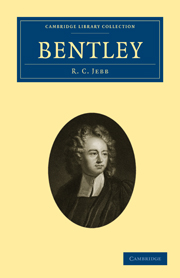Book contents
- Frontmatter
- PREFATORY NOTE
- Contents
- CHAPTER I EARLY LIFE. THE LETTER TO MILL
- CHAPTER II THE BOYLE LECTURES
- CHAPTER III LEARNED CORRESPONDENCE. THE KING'S LIBRARIAN
- CHAPTER IV THE CONTROVERSY ON THE LETTERS OF PHALARIS
- CHAPTER V BENTLEY'S DISSERTATION
- CHAPTER VI TRINITY COLLEGE, CAMBRIDGE
- CHAPTER VII BENTLEY AS MASTER OF TRINITY
- CHAPTER VIII LITERARY WORK AFTER 1700.—HORACE
- CHAPTER IX OTHER CLASSICAL STUDIES. — TERENCE. — MANILIUS. — HOMER
- CHAPTER X THE PROPOSED EDITION OF THE NEW TESTAMENT
- CHAPTER XI ENGLISH STYLE. EDITION OF PARADISE LOST
- CHAPTER XII DOMESTIC LIFE. LAST YEARS
- CHAPTER XIII BENTLEY'S PLACE IN THE HISTORY OF SCHOLARSHIP
CHAPTER X - THE PROPOSED EDITION OF THE NEW TESTAMENT
Published online by Cambridge University Press: 07 September 2010
- Frontmatter
- PREFATORY NOTE
- Contents
- CHAPTER I EARLY LIFE. THE LETTER TO MILL
- CHAPTER II THE BOYLE LECTURES
- CHAPTER III LEARNED CORRESPONDENCE. THE KING'S LIBRARIAN
- CHAPTER IV THE CONTROVERSY ON THE LETTERS OF PHALARIS
- CHAPTER V BENTLEY'S DISSERTATION
- CHAPTER VI TRINITY COLLEGE, CAMBRIDGE
- CHAPTER VII BENTLEY AS MASTER OF TRINITY
- CHAPTER VIII LITERARY WORK AFTER 1700.—HORACE
- CHAPTER IX OTHER CLASSICAL STUDIES. — TERENCE. — MANILIUS. — HOMER
- CHAPTER X THE PROPOSED EDITION OF THE NEW TESTAMENT
- CHAPTER XI ENGLISH STYLE. EDITION OF PARADISE LOST
- CHAPTER XII DOMESTIC LIFE. LAST YEARS
- CHAPTER XIII BENTLEY'S PLACE IN THE HISTORY OF SCHOLARSHIP
Summary
Dr John Mill published in 1707 his edition of the Greek Testament, giving in foot-notes the various readings which he had collected by the labour of thirty years. To understand the impression which this work produced, it is necessary to recall the nature of its predecessors. The Greek text of the New Testament, as then generally read, was ultimately based on two sixteenth century editions; that of Erasmus (Basel, 1516), which had been marked by much carelessness; and that due chiefly to Stunica, in the ‘Complutensian’ Polyglott (so called from Complūtum, or Alcalá de Henares) of Cardinal Ximenes, printed in 1514, and probably published in 1522. The folio edition printed by Robert Estienne at Paris in 1550 was founded on the text of Erasmus. The Elzevir editions, of which the first appeared in 1624, gave the text of Estienne as imperfectly revised by the reformer Beza. The second Elzevir edition (1633) declared this to be ‘the text now received by all.’ Hence it came to be known as the ‘Received Text.’
The existence of various readings, though a wellknown, was hardly a prominent fact. Some had been given in the margin of the folio Estienne; Beza had referred to others; more had been noticed by Walton in the Greek Testament of his Polyglott (1657), and by Bishop Fell in his small edition (1675). The sources of textual evidence generally had been described and discussed with intelligence and candour by the French scholar Simon (1689–95). But Mill's edition was the tirst which impressed the public mind by marshalling a great array of variants, roughly estimated at thirty thousand.
- Type
- Chapter
- Information
- Bentley , pp. 157 - 171Publisher: Cambridge University PressPrint publication year: 2010First published in: 1882



